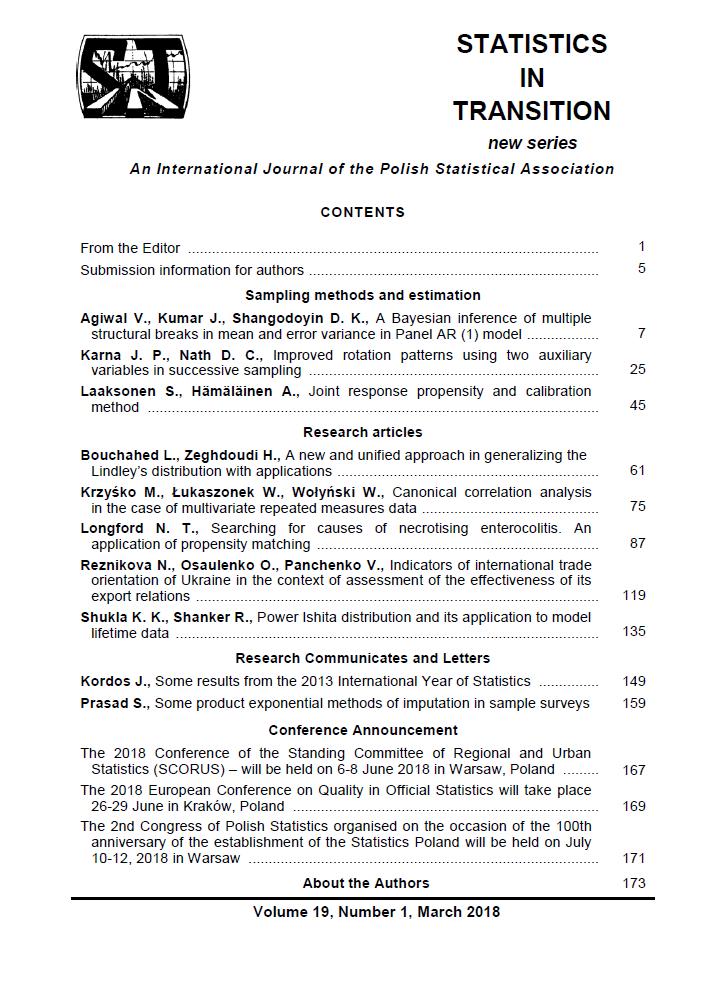ARTICLE
ABSTRACT
This paper explores the effect of multiple structural breaks to estimate the parameters and test the unit root hypothesis in panel data time series model under Bayesian perspective. These breaks are present in both mean and error variance at the same time point. We obtain Bayes estimates for different loss function using conditional posterior distribution, which is not coming in a closed form, and this is approximately explained by Gibbs sampling. For hypothesis testing, posterior odds ratio is calculated and solved via Monte Carlo Integration. The proposed methodology is illustrated with numerical examples.
KEYWORDS
panel data model, autoregressive model, structural break, MCMC, posterior odds ratio
REFERENCES
ALTISSIMO, F., CORRADI, V., (2003). Strong rules for detecting the number of breaks in a time series. Journal of Econometrics, 117 (2), pp. 207–244.
AUE, A., HORVÁTH, L., (2013). Structural breaks in time series. Journal of Time Series Analysis, 34 (1), pp. 1–16.
BAI, J., PERRON, P., (1998). Estimating and testing linear models with multiple structural changes. Econometrica, 66 (1), pp. 47–78.
BAI, J., PERRON, P., (2003). Computation and analysis of multiple structural change models. Journal of Applied Econometrics, 18 (1), pp. 1–22.
EO, Y., MORLEY, J., (2015). Likelihood-based confidence sets for the timing of structural breaks. Quantitative Economics, 6, pp. 463–497.
EO, Y., (2012). Bayesian Inference about the Types of Structural Breaks When There are Many Breaks. Available at SSRN: http://dx.doi.org/10.2139/ssrn.2011825
GEMAN, S., GEMAN, D., (1984). Stochastic relaxation, Gibbs distribution and the Bayesian restoration of images. IEEE Transactions on Pattern Analysis and Machine Intelligence, 6, pp. 721–741.
GEWEKE, J., JIANG, Y., (2011). Inference and prediction in a multiple-structural break model. Journal of Econometrics, 163 (2), pp. 172–185.
JIN, B., SHI, X., WU, Y., (2013). A novel and fast methodology for simultaneous multiple structural break estimation and variable selection for nonstationary time series models. Statistics and Computing, 23 (2), pp. 1–11.
LI, D., QIAN, J., SU, L., (2016). Panel data models with interactive fixed effects and multiple structural breaks. Journal of the American Statistical Association, 111 (516), pp. 1804–1819.
LI, X., (2004). A Quasi-Bayesian Analysis of Structural Breaks in China's Output and Productivity Series. International Journal of Business and Economics, 3 (1), pp. 57–65.
LIU, D., LI, R., WANG, Z., (2011). Testing for structural breaks in panel varying coefficient models: with an application to OECD health expenditure. Empirical Economics, 40 (1), pp. 95–118.
MELIGKOTSIDOU, L., TZAVALIS, E., VRONTOS, I. D., (2017). On Bayesian Analysis and Unit Root Testing for Autoregressive Models in the Presence of Multiple Structural Breaks. Econometrics and Statistics, 4, pp.70–90.
PHILLIPS, P.C., (1991) To criticize the critics: An objective Bayesian analysis of stochastic trends. Journal of Applied Econometrics, 6, pp.333–364.
PREUSS, P., PUCHSTEIN, R., DETTE, H., (2015). Detection of multiple structural breaks in multivariate time series. Journal of the American Statistical Association, 110 (510), pp. 654–668.
SCHOTMAN, P. C., VAN DIJK, H. K., (1991). A Bayesian routes to unit roots. Journal of Applied Econometrics, 6, pp. 387–401.
SUGITA, K., (2006). Bayesian Analysis of Dynamic Multivariate Models with Multiple Structural Breaks, No 2006-14, Discussion Papers, Graduate School of Economics, Hitotsubashi University, http://EconPapers.repec.org/RePEc:hit:econdp:2006-14.
WANG, J., ZIVOT, E., (2000). A Bayesian time series model of multiple structural changes in level, trend, and variance. Journal of Business & Economic Statistics, 18, pp. 374–386.
ZEILEIS, F., LEISCH, K., H., KLEIBER, C., (2002). Strucchange: An R package for testing for structural change in linear regression models. Journal of Statistical Software, 7, pp. 1–38
